A quillon is either of two transverse projections forming a simple crossguard of a sword, or the crossguard as a whole.
Quillon may also refer to:
- Quillón, a commune and city in Chile
A quillon is either of two transverse projections forming a simple crossguard of a sword, or the crossguard as a whole.
Quillon may also refer to:
A sword is an edged, bladed weapon intended for manual cutting or thrusting. Its blade, longer than a knife or dagger, is attached to a hilt and can be straight or curved. A thrusting sword tends to have a straighter blade with a pointed tip. A slashing sword is more likely to be curved and to have a sharpened cutting edge on one or both sides of the blade. Many swords are designed for both thrusting and slashing. The precise definition of a sword varies by historical epoch and geographic region.

Szczerbiec is the ceremonial sword used in the coronations of most Polish monarchs from 1320 to 1764. It now is displayed in the treasure vault of the royal Wawel Castle in Kraków, as the only preserved part of the medieval Polish crown jewels. The sword is noted for its hilt, decorated with magical formulae, Christian symbols, and floral patterns, as well as for the narrow slit in the blade which holds a small shield with the coat of arms of Poland. The name of the sword is derived from the Polish word szczerba, and its meaning is incorrectly perceived as "the Notched Sword" or "the Jagged Sword", though the edges of its blade are straight and smooth. Proper meaning and rendering into English would be "the Notching/Jagging Sword" — as "a sword that is meant to notch/jag other weapons".
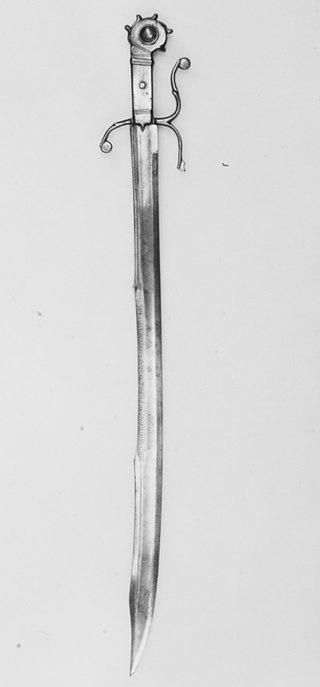
A falchion is a one-handed, single-edged 37-40in. sword of European origin. Falchions are found in different forms from around the 13th century up to and including the 16th century. In some versions, the falchion looks rather like the seax and later the sabre, and in other versions more like a machete with a crossguard.

The hilt is the handle of a knife, dagger, sword, or bayonet, consisting of a guard, grip, and pommel. The guard may contain a crossguard or quillons. A tassel or sword knot may be attached to the guard or pommel.

A longsword is a type of European sword characterized as having a cruciform hilt with a grip for primarily two-handed use, a straight double-edged blade of around 80 to 110 cm, and weighing approximately 2 to 3 kg.

A shamshir is a type of Persian/Iranian sword with a radical curve. The name is derived from the Persian word shamshīr, which is made of two words sham ("fang") and shir ("lion"). The curved "scimitar" sword family includes the shamshir, kilij, talwar, pulwar, and nimcha.

The pulwar or pulouar (پلوار) is a single-handed curved sword originating in Afghanistan.

The butterfly sword is a short dao, or single-edged sword, originally from southern China, though it has also seen use in the north. It is thought that butterfly swords date from the early 19th century. Several English language accounts from the 1840s describe local militia in Guangdong being trained in the "double swords", short swords with a hook extending from the guard, and fitting into a single scabbard.
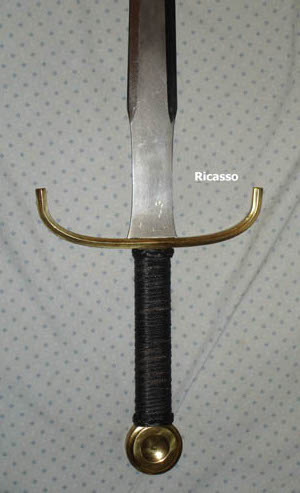
A ricasso is an unsharpened length of blade just above the guard or handle on a knife, dagger, sword, or bayonet. Blades designed this way appear at many periods in history in many parts of the world and date back to at least the Bronze Age—essentially, as long as humans have shaped cutting tools from metals.

The Zweihänder, also Doppelhänder ("double-hander"), Beidhänder ("both-hander"), Bihänder, or Bidenhänder, is a large two-handed sword that was used primarily during the 16th century.

A sword's crossguard or cross-guard is a bar between the blade and hilt, essentially perpendicular to them, intended to protect the wielder's hand and fingers from opponents' weapons as well as from his or her own blade. Each of the individual bars on either side is known as a quillon or quillion.
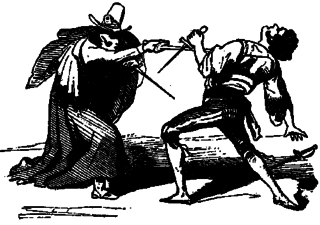
The parrying dagger is a category of small handheld weapons from the European late Middle Ages and early Renaissance. These weapons were used as off-hand weapons in conjunction with a single-handed sword such as a rapier. As the name implies they were designed to parry, or defend, more effectively than a simple dagger form, typically incorporating a wider guard, and often some other defensive features to better protect the hand as well. They may also be used for attack if an opportunity arises. The general category includes two more specific types, the swordbreaker and trident dagger.

A barrel shroud is an external covering that envelops the barrel of a firearm to prevent unwanted direct contact with the barrel. Moving coverings such as pistol slides, fore-end extensions of the gunstock/chassis that do not fully encircle the barrel, and the receiver of a firearm itself are generally not described as barrel shrouds, though they can functionally act as such.

The Sword of Stalingrad is a bejewelled ceremonial longsword specially forged and inscribed by command of King George VI of the United Kingdom as a token of homage from the British people to the Soviet defenders of the city during the Battle of Stalingrad. On 29 November 1943, it was presented to Marshal Joseph Stalin by British Prime Minister Winston Churchill at a ceremony during the Tehran Conference, in the presence of President Franklin D. Roosevelt and an honour guard.

A claymore is either the Scottish variant of the late medieval two-handed sword or the Scottish variant of the basket-hilted sword. The former is characterised as having a cross hilt of forward-sloping quillons with quatrefoil terminations and was in use from the 15th to 17th centuries.
Chappe may refer to:

The basket-hilted sword is a sword type of the early modern era characterised by a basket-shaped guard that protects the hand. The basket hilt is a development of the quillons added to swords' crossguards since the Late Middle Ages. This variety of sword is also sometimes referred to as the broadsword, though this term may also be applied loosely and imprecisely to other swords.
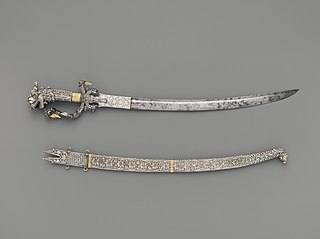
A kastane or kasthane is a short traditional ceremonial or decorative single-edged Sri Lankan sword. The sword is featured in the Flag of Sri Lanka.
Colchagua may refer to:
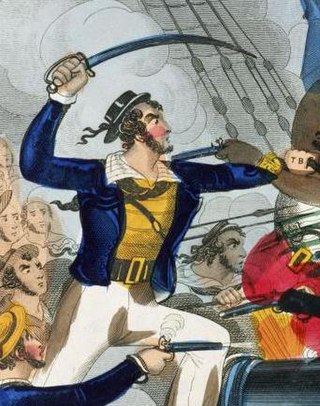
Ratings of the Royal Navy have used cutlasses, short, wide bladed swords, since the early 18th century. These were originally of non-uniform design but the 1804 Pattern, the first Navy-issue standard cutlass, was introduced at the start of the 19th century. This was a bluntish weapon that was perhaps intended for cutting away canvas and ropes rather than as a thrusting combat weapon. The 1845 Pattern cutlass introduced a bowl-style hand guard which provided greater protection, with a longer and more curved blade. Its sharper point made it more useful for thrusting attacks, which were now emphasised in the drill manual. The 1845 Pattern was modified several times including shortening and straightening the blades, which weakened them. The 1889 Pattern had a straight, spear-pointed blade with a hilt that curved outwards to catch and redirect an opponent's sword point. The 1900 Pattern, the last navy-issue cutlass, was similar to its predecessor with the introduction of a fuller and a hilt insert that cushioned the user's little finger. The cutlass was withdrawn from service in 1936 but remains in use for ceremonial purposes. It is thought that it was last used in combat in 1900 during the Boxer Rebellion.